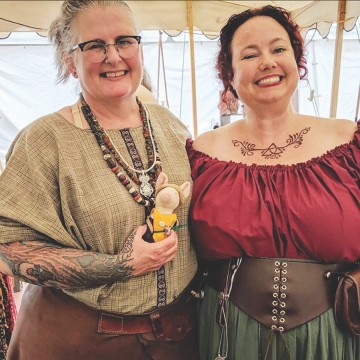The Maryland Renaissance Festival
Do you smell the roasting smoked turkey legs? Hear the clanging of steel as jousters meet on the field of battle? Spot courtiers from the 1500s showing up in everyday scenes?
Yes, it’s that time of year again. The Renaissance Festival is Chesapeake Country’s unofficial sign that summer is ending.
In the festival’s 43rd season, you step back in time and enter the Village of Revel Grove, with more than 140 artisans and crafters. Five taverns plus 42 food and beverage emporiums satisfy appetites.
Unique in the festival world, the Maryland Renaissance Festival dramatizes a new storyline each year from the reign of England’s King Henry VIII. Over the years, all six of his wives make their appearances.
This year, 1532, the King woos Anne Boleyn. King Henry has banished his first wife, Catherine of Aragon, so he can win over the young beauty who has caught his eye. He has declared Anne the Marquess of Pembroke, granting her the first hereditary peerage created for a woman.
History buffs know that what started so promisingly for Boleyn doesn’t end well.
Over the Years
From a small start, the RenFest has grown spectacular.
“The festival began in Columbia in 1977 with 17,000 customers over four weekends,” says Jules Smith, owner and general manager. “We now run nine weekends and attract more than 300,000 people a year. For the first four years we had only four stages; now we have 10.”
“One of the great features of the festival is the street entertainment, which has grown in characters and music as the festival has grown,” Smith says.
Today that means you’ll be hard-pressed to find a lull in the entertainment in Revel Village. The almost continuing entertainment features more than 200 performers on 10 stages.
Artist Ann Lyneah Curtis, who runs Masquerade Face-Casting and Royal Relics: Curious Oddities of Skin and Bones, has been a part of the Festival since 1994. On weekends, she applies plaster gauze bandages to take casts of the face, body or hand. She uses the casting as a mold and presses a clay slab into the interior of the cast. Detail transfers to the clay, and Curtis creates from the image a work of art to suit her subject’s desires.
“At the beginning, you’d find all walks of culture at the festival,” Curtis says. “Now it’s much more family oriented.”
To meet the dining demands of so many family members, food has become a much bigger deal.
“Initially, we ran all the food,” Smith says. “By year four we had let others handle the food until we started reacquiring it. We currently operate 12 food operations and 22 beverage facilities. Four independent food vendors operate an additional 11 food stands.”
From fried cheese — this writer admits she’d go for nothing more than this culinary wonder — to barbecued pork chops on a stick, you’ll find many odd delicacies. Delights include appetizers and snacks such as chili poppers, crab rangoon, spring or egg rolls and crab pretzels; heartier meals like grilled steak sandwiches, meatballs, ribs and shepherds pie. Not a carnivore? Try mac and cheese on a stick, Belgium waffles and cheese quesadillas. There are plenty of dessert choices, too, such as chocolate-covered bananas, cheesecake on a stick and ice cream shakes.
Among the Shops
Shopkeeper Petronella Thomann, a native of the Netherlands who has returned to the festival for 35 years, has nearly as long a perspective on its growth as does founder Smith. Argenti, her jewelry and European  tapestry shop, has grown along with the festival.
tapestry shop, has grown along with the festival.
“I came in originally with a tent and a dirt floor,” she says. “I had a little spot near the jousting area. The floor floated with the rain, and I had to wear knickers and boots. I now have a huge booth near the turkey booths.”
Virginia Virkus, who owns Dancing Pig Pottery, was a high-schooler when she began selling pottery vases and housewares at the festival. That was more than 30 years ago.
Virkus, her staff and her shop “dress the part and look very period” to convince guests it’s a real village. Shopkeepers consider themselves performers during interactions and sales, she said.
“I think the one-on-one interactions our guests have are what makes it unique,” Virkus said. “Those moments, in shops like mine, are why folks come back year after year.”
Petronella, the jeweler, says the owners are why both guests and artisans return year after year.
“I do seven Renaissance festivals a year,” she says, “and the Maryland Renaissance Festival is by far, the best fair you could possibly do. The managers are great. They are committed to keeping the artists here. Other festivals are not.”
But not at the guests’ expense. “Among similar major festivals in the country, we are one of only two that does not allow hat-passing,” says Smith. “We feel it is bothersome to the customer who has paid an admission.
 “We also have a strict vendor policy and jury procedure that allows us to select some of the best Renaissance-style vendors there are.”
“We also have a strict vendor policy and jury procedure that allows us to select some of the best Renaissance-style vendors there are.”
The festival thrives on history, but it’s looking at the future. “We continue to scout for new talent and enhance the customer experience,” Smith says. “New attendees are always impressed by the size.”
He advises a virtual visit (www.marylandrenaissancefestival.com) to see what’s available and get ideas of shows to visit before arriving at Revel Village. “Online tickets assure being able to visit, as the event can sell out,” he says. “With an online ticket you can arrive any time instead of early to be certain you can get in.”
The event has grown so large that it can’t all be seen in one day. “It is more than a full-day’s event,” Smith says, “so it can take time to visit.”
